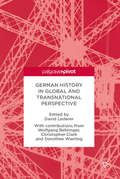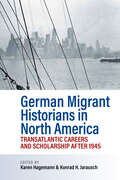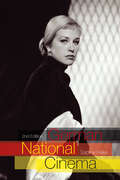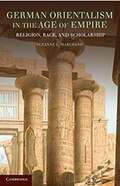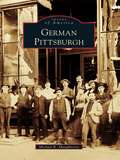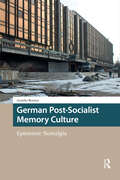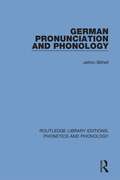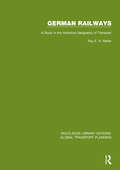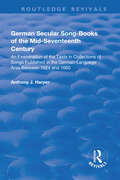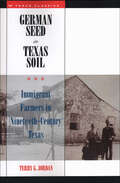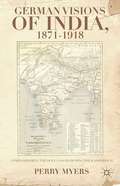- Table View
- List View
German Foreign Policy Towards Emerging Powers: Co-Shaping Globalization (Contributions to International Relations)
by Tomasz MorozowskiThis book examines the complex process of German foreign policy adaptation to a shifting global landscape, especially to the rise of new powers. Addressing a scholarly audience, the book sheds light on the evolution of Germany's post-reunification international role beyond the Euro-Atlantic structure. Grounded within the theoretical framework of neoclassical realism, the book analyzes the inner workings of Germany's global policy formation. It scrutinizes the state's relations with rising and emerging powers, including China, Brazil, India, South Africa, Mexico, Vietnam, Indonesia, Nigeria, Saudi Arabia, and the United Arab Emirates, exploring the details of Berlin's approach. The book presents the motives, goals, instruments, and future prospects of Germany's foreign policy regarding these states. It further explores the dynamics of Germany's civilian and economic power, while addressing the growing call for increased responsibility within the European Union as well as in global politics. Readers will gain insight into the foundations, tools, and effectiveness of Germany's foreign policy, providing a quintessential case study of how a European state navigates the challenges of a rapidly changing global landscape. This makes the book a must-read for researchers specializing in German studies as well as for scholars of international relations and foreign policy.
German History in Global and Transnational Perspective
by David LedererThis is a collection of essays from three of the world’s pre-eminent historians of Germany, which consider German history in global and transnational contexts. It is well known that transnationalism has exploded in the last decade or so as a new academic subfield of international and global history. What the transnationalism literature often ignores or downplays, however, is the role of the nation-state in making the transnational possible in the first place, as noted in its very etymological origins. This volume traces this dynamic from a different vantage-point, namely the relationship between German history and transnationalism. Each essay applies a transnational framework in fresh and original ways in order to illuminate different facets of the connections between Germany and the wider world in the modern period. Together they will encourage the rethinking of assumptions about key moments and developments in the history of modern Germany, and foster reflection on the evolving nature of German history as a subject studied in the twenty-first century.
German Idealism and the Concept of Punishment
by Joseph J. Kominkiewicz Frances BrownAgainst the background of early modernism - a period that justified punishment by general deterrence - Kant is usually thought to represent a radical turn towards retributivism. For Kant, and later for Fichte and Hegel, a just punishment respects the humanity inherent in the criminal, and serves no external ends - it is instituted only because the criminal deserves it. In this original study, Jean-Christophe Merle uses close analysis of texts to show that these philosophers did not in fact hold a retributivist position, or even a mixed position; instead he traces in their work the gradual emergence of views in favour of deterrence and resocialisation. He also examines Nietzsche's view that morality rests on the rejection of retribution. His final chapter offers a challenge to the retributivist position, and a defence of resocialisation, in the context of current legal theory and practice concerning the punishment of crimes against humanity.
German Idealism and the Jew: The Inner Anti-Semitism of Philosophy and German Jewish Responses
by Michael MackIn German Idealism and the Jew, Michael Mack uncovers the deep roots of anti-Semitism in the German philosophical tradition. While many have read German anti-Semitism as a reaction against Enlightenment philosophy, Mack instead contends that the redefinition of the Jews as irrational, oriental Others forms the very cornerstone of German idealism, including Kant's conception of universal reason. Offering the first analytical account of the connection between anti-Semitism and philosophy, Mack begins his exploration by showing how the fundamental thinkers in the German idealist tradition—Kant, Hegel, and, through them, Feuerbach and Wagner—argued that the human world should perform and enact the promises held out by a conception of an otherworldly heaven. But their respective philosophies all ran aground on the belief that the worldly proved incapable of transforming itself into this otherworldly ideal. To reconcile this incommensurability, Mack argues, philosophers created a construction of Jews as symbolic of the "worldliness" that hindered the development of a body politic and that served as a foil to Kantian autonomy and rationality. In the second part, Mack examines how Moses Mendelssohn, Heinrich Heine, Franz Rosenzweig, and Freud, among others, grappled with being both German and Jewish. Each thinker accepted the philosophies of Kant and Hegel, in varying degrees, while simultaneously critiquing anti-Semitism in order to develop the modern Jewish notion of what it meant to be enlightened—a concept that differed substantially from that of Kant, Hegel, Feuerbach, and Wagner. By speaking the unspoken in German philosophy, this book profoundly reshapes our understanding of it.
German Immigrants, Race, and Citizenship in the Civil War Era
by Alison Clark EffordThis study of Civil War-era politics explores how German immigrants influenced the rise and fall of white commitment to African-American rights. Intertwining developments in Europe and North America, Alison Clark Efford describes how the presence of naturalized citizens affected the status of former slaves and identifies 1870 as a crucial turning point. That year, the Franco-Prussian War prompted German immigrants to reevaluate the liberal nationalism underpinning African-American suffrage. Throughout the period, the newcomers' approach to race, ethnicity, gender, and political economy shaped American citizenship law.
German Influences in Louisville (American Heritage)
by C. Robert UllrichThe first German immigrants in Louisville were shoemakers, bakers, butchers, blacksmiths and brewers--literally everything from basket makers to carriage manufacturers. Later, these industrious immigrants became captains of industry and influence in the city. August Prante's family built many of the magnificent organs for Louisville churches. Abraham Flexner was a pioneer in medical education, while Louis Brandeis was the first Jew to serve on the United States Supreme Court. William George Stuber, the son of Louisville photographer Michael Stuber, became the president of the Eastman Kodak Company. C. Robert Ullrich and Victoria A. Ullrich present a series of essays detailing how German immigrants shaped the industry and culture of Louisville.
German Jewry and the Allure of the Sephardic
by John M. EfronIn the eighteenth and nineteenth centuries, as German Jews struggled for legal emancipation and social acceptance, they also embarked on a program of cultural renewal, two key dimensions of which were distancing themselves from their fellow Ashkenazim in Poland and giving a special place to the Sephardim of medieval Spain. Where they saw Ashkenazic Jewry as insular and backward, a result of Christian persecution, they depicted the Sephardim as worldly, morally and intellectually superior, and beautiful, products of the tolerant Muslim environment in which they lived. In this elegantly written book, John Efron looks in depth at the special allure Sephardic aesthetics held for German Jewry.Efron examines how German Jews idealized the sound of Sephardic Hebrew and the Sephardim's physical and moral beauty, and shows how the allure of the Sephardic found expression in neo-Moorish synagogue architecture, historical novels, and romanticized depictions of Sephardic history. He argues that the shapers of German-Jewish culture imagined medieval Iberian Jewry as an exemplary Jewish community, bound by tradition yet fully at home in the dominant culture of Muslim Spain. Efron argues that the myth of Sephardic superiority was actually an expression of withering self-critique by German Jews who, by seeking to transform Ashkenazic culture and win the acceptance of German society, hoped to enter their own golden age.Stimulating and provocative, this book demonstrates how the goal of this aesthetic self-refashioning was not assimilation but rather the creation of a new form of German-Jewish identity inspired by Sephardic beauty.
German Jewry: Its History and Sociology
by Joseph B. MaierThis history of post-Emancipation German Jewry and of the Holocaust aftermath has received considerable scholarly attention. The study of Jewish life in Germany in the 1930s and the migration impelled by the Nazi period has, on the other hand, been comparatively neglected. The work of Werner J. Cahnman (1902-1980) goes a long way toward filling this gap.Cahnman's examination of "the Jewish people that dwells among the nations" is focused on Germany because it was the country "where in modern times the symbiosis . . . has been most intimate and it also has been the country where the conflict degenerated into the monstrosity of the Holocaust." This representative anthology of his essays shares a common theme, although the examples differ in thought, method and style. Whether he explores the stratification of pre-Emancipation German Jewry, the rise of the Jewish national movement in Austria, or such an esoteric topic as the influence of the kabbalistic tradition on German idealist philosophy; whether he muses on the writing of Jewish history or reports on his firsthand experience in Dachau, Cahnman's work reflects central concerns of his personal and scholarly existence as a German Jew. Because he usually combined extensive empirical data with his own background and personal experience, he is able to craft a penetrating analysis of the recent history of Jewish life in Central Europe. Werner Cahnman believed that the "writing of history is vital for the continued cultural identity of the human kind."
German Jews in Love: A History (Stanford Studies in Jewish History and Culture)
by Christian BaileyThis book explores the dynamic role of love in German-Jewish lives, from the birth of the German Empire in the 1870s, to the 1970s, a generation after the Shoah. During a remarkably turbulent hundred-year period when German Jews experienced five political regimes, rapid urbanization, transformations in gender relations, and war and genocide, the romantic ideals of falling in love and marrying for love helped German Jews to develop a new sense of self. Appeals to romantic love were also significant in justifying relationships between Jews and non-Jews, even when those unions created conflict within and between communities. By incorporating novel approaches from the history of emotions and life-cycle history, Christian Bailey moves beyond existing research into the sexual and racial politics of modern Germany and approaches a new frontier in the study of subjectivity and the self. German Jews in Love draws on a rich array of sources, from newspapers and love letters to state and other official records. Calling on this evidence, Bailey shows the ways German Jews' romantic relationships reveal an aspect of acculturation that has been overlooked: how deeply cultural scripts worked their way into emotions; those most intimate and seemingly pre-political aspects of German-Jewish subjectivity.
German Migrant Historians in North America: Transatlantic Careers and Scholarship after 1945
by Karen Hagemann and Konrad H. JarauschThe migration experiences, career paths, and scholarship of historians born in Germany who started emigrating to North America in the 1950s have had a unique impact on the transatlantic practice of Central European History. German Migrant Historians in North America analyzes the experiences of this postwar group of scholars, and asks what informed their education and career choices, and what motivated them to emigrate to North America. The contributors reflect on how these migration experiences informed their own research and teaching, and particularly discuss the more general development of the transatlantic exchange between German and American historians in the scholarship on Modern Central European History.
German National Cinema (National Cinemas)
by Sabine HakeGerman National Cinema is the first comprehensive history of German film from its origins to the present. In this new edition, Sabine Hake discusses film-making in economic, political, social, and cultural terms, and considers the contribution of Germany's most popular films to changing definitions of genre, authorship, and film form. The book traces the central role of cinema in the nation’s turbulent history from the Wilhelmine Empire to the Berlin Republic, with special attention paid to the competing demands of film as art, entertainment, and propaganda. Hake also explores the centrality of genre films and the star system to the development of a filmic imaginary. This fully revised and updated new edition will be required reading for everyone interested in German film and the history of modern Germany.
German Nationalism and Indian Political Thought: The Influence of Ancient Indian Philosophy on the German Romantics
by Alexei PimenovThis book examines the influence of Indian socio-political thought, ideas, and culture on German Romantic nationalism. It suggests that, contrary to the traditional view that the concepts of nationalism have moved exclusively from the West to the rest of the world, in the crucial case of German nationalism, the essential intellectual underpinnings of the nationalist discourse came to the West, not from the West. The book demonstrates how the German Romantic fascination with India resulted in the adoption of Indian models of identity and otherness and ultimately shaped German Romantic nationalism. The author illustrates how Indian influence renovated the scholarly design of German nationalism and, at the same time, became central to pre-modern and pre-nationalist models of identity, which later shaped the Aryan myth. Focusing on the scholarship of Friedrich Schlegel, Otmar Frank, Joseph Goerres, and Arthur Schopenhauer, the book shows how, in explaining the fact of the diversity of languages, peoples, and cultures, the German Romantics reproduced the Indian narrative of the degradation of some Indo-Aryan clans, which led to their separation from the Aryan civilization. An important resource for the nexus between Indology and Orientalism, German Indian Studies and studies of nationalism, this book will be of interest to researchers working in the fields of history, European and South Asian area studies, philosophy, political science, and IR theory.
German New York City (Images of America)
by Richard PanchykGerman New York City celebrates the rich cultural heritage of the hundreds of thousands of German immigrants who left the poverty and turmoil of 19th- and 20th-century Europe for the promise of a better life in the bustling American metropolis. German immigration to New York peaked during the 1850s and again during the 1880s, and by the end of the 19th century New York had the third-largest German-born population of any city worldwide. German immigrants established their new community in a downtown Manhattan neighborhood that became known as Kleindeutschland or Little Germany. During the late 19th and early 20th centuries, much of the German population moved north to the Upper East Side's Yorkville and subsequently spread out to the other boroughs of the city.
German Orientalism in the Age of Empire: Religion, Race, and Scholarship (Publications of the German Historical Institute Series)
by Suzanne L. MarchandNineteenth-century studies of the Orient changed European ideas and cultural institutions in more ways than we usually recognize. “Orientalism” certainly contributed to European empire-building, but it also helped to destroy a narrow Christian-classical canon. <p><p>This carefully researched book provides the first synthetic and contextualized study of German Orientalistik, a subject of special interest because German scholars were the pace-setters in oriental studies between about 1830 and 1930, despite entering the colonial race late and exiting it early. The book suggests that we must take seriously German orientalism’s origins in Renaissance philology and early modern biblical exegesis and appreciate its modern development in the context of nineteenth- and early-twentieth-century debates about religion and the Bible, classical schooling, and Germanic origins. <p><p>In ranging across the subdisciplines of Orientalistik, German Orientalism in the Age of Empire introduces readers to a host of iconoclastic characters and forgotten debates, seeking to demonstrate both the richness of this intriguing field and its indebtedness to the cultural world in which it evolved.
German Orientalism: The Study of the Middle East and Islam from 1800 to 1945 (Culture and Civilization in the Middle East)
by Ursula WokoeckDuring the nineteenth century and the first half of the twentieth, German universities were at the forefront of scholarship in Oriental studies. Drawing upon a comprehensive survey of thousands of German publications on the Middle East from this period, this book presents a detailed history of the development of Orientalism. Offering an alternative to the view of Orientalism as a purely intellectual pursuit or solely as a function of politics, this book traces the development of the discipline as a profession. The author discusses the interrelation between research choices and employment opportunities at German universities, examining the history of the discipline within the framework of the humanities. On that basis, topics such as the establishment of Oriental philology; the process of institutional differentiation between the study of Semitic languages and the study of Sanskrit and comparative linguistics; the emergence of Assyriology; and the partial establishment of Islamic studies are explored. This unique perspective on the history of Oriental studies in the German tradition contributes to the understanding of the wider history of the field, and will be of great interest to scholars and students of Middle East studies, history, and German history in particular.
German Pittsburgh (Images of America)
by Michael R. ShaughnessyGerman Pittsburgh explores the multifaceted cultural history of German-speaking immigrants and residents in the Greater Pittsburgh area. Today over one quarter of the city's residents claim German heritage, the largest ethnic group in the region. German-speaking Pittsburghers include names like H. J. Heinz, Honus Wagner, and the Kaufmanns, and they produced beloved Pittsburgh beers such as Iron City and Penn Pilsner. It might be surprising to know that German was an official language of the city at one time, and a daily German newspaper was printed from the mid-1800s up through World War II. Today remnants of the German-speaking community can be found on the North Side, the South Side, Troy Hill, and Mount Oliver, to name a few. German Pittsburgh provides an overview of the contributions that this diverse ethnic community has made and is making today in the city.
German Post-Socialist Memory Culture: Epistemic Nostalgia (Heritage and Memory Studies)
by Amieke BoumaAfter German unification, former officers of the GDR state security service united with GDR professors and cultural managers to establish the East German Committee of Associations (OKV). On the basis of encompassing oral history into this complex web of interest organizations and memory clubs, Bouma argues that these activists are driven by an epistemic nostalgia: a longing for the time when their political understanding of the world was seemingly unchallenged. Far from constituting a ‘second life of the Stasi’, the main goal of OKV associations has been to validate the personal biographies of their activists, against the now prevalent view that the GDR was a ‘state of injustice’. While the OKV quickly adapted to the new legal procedures in post-socialist Germany, their staunch defence of the GDR heritage complicates their relation to SED successor party Die Linke and other radical left parties and associations, even when they share practical goals. Breaking new ground in the study of post-socialist memory culture, this book explains why former GDR cadres replicate GDR memory culture against their stigmatized status in unified Germany.
German Pronunciation and Phonology (Routledge Library Editions: Phonetics and Phonology #2)
by Jethro BithellFirst published in 1952. This book does not confine itself to German phonetics; it aims rather at showing by what processes and tricks of sound words have been shaped in the course of years; it is therefore a book on phonology as well. It should have a wide appeal to students of German. Moreover, since the treatment of laws and sound processes is comparative, it will be useful to students of other languages, particularly of the Scandinavian group and Dutch.
German Railways: A Study in the Historical Geography of Transport (Routledge Library Edtions: Global Transport Planning #14)
by Roy E. MellorOriginally published in 1979, this volume is an invaluable study of a railway system and its adjustment to changing political-geographical conditions, as well as changes in economic and social geography. Each change in the territorial extent or in the internal territorial-administrative organisation of Germany has had its repercussions upon the spatial pattern of the country’s economy and consequently upon the demand for transport. Furthermore, the central position of Germany within the continent has given an added importance to the role of its railways in the overall pattern of the European railway system. For the transport geographer the comparisons and contrasts with the British railway system are particularly insightful.
German Secular Song-books of the Mid-seventeenth Century: An Examination of the Texts in Collections of Songs Published in the German-language Area Between 1624 and 1660
by Anthony J. HarperThis title was first published in 2003. The secular song of the 17th century represents a relatively neglected area of German culture. In this book, Anthony J. Harper first studies the songs of the two great models of the time, Martin Opitz and Paul Fleming, following this with an analysis of the song-books and collections from three regions: the North-East, Central Germany, and the North. The procedure is thus both historical and geographical. The texts of these songs are examined in relation to structural principles, thematic range and stylistic treatment. Harper establishes common features and regional variations of this genre, which involves love-poetry, songs of manners with colourful portrayals of everyday life, and comic songs in a lower stylistic register. Particular attention is paid to the work of Albert and Dach in Konigsberg, Finckelthaus, Schirmer, Krieger and Schoch in Leipzig and Dresden, and Rist, Voigtlander, Zesen, Greflinger and Stieler in the Hamburg region. Where appropriate, the book assesses the role of musical settings, while not seeking to offer technical insights into musical matters. Of value to scholars of German literature, this study should also be of interest to musicologists working on the Renaissance and Baroque periods.
German Secular Song-books of the Mid-seventeenth Century: An Examination of the Texts in Collections of Songs Published in the German-language Area Between 1624 and 1660 (Routledge Revivals)
by Anthony J. HarperThis title was first published in 2003. The secular song of the 17th century represents a relatively neglected area of German culture. In this book, Anthony J. Harper first studies the songs of the two great models of the time, Martin Opitz and Paul Fleming, following this with an analysis of the song-books and collections from three regions: the North-East, Central Germany, and the North. The procedure is thus both historical and geographical. The texts of these songs are examined in relation to structural principles, thematic range and stylistic treatment. Harper establishes common features and regional variations of this genre, which involves love-poetry, songs of manners with colourful portrayals of everyday life, and comic songs in a lower stylistic register. Particular attention is paid to the work of Albert and Dach in Konigsberg, Finckelthaus, Schirmer, Krieger and Schoch in Leipzig and Dresden, and Rist, Voigtlander, Zesen, Greflinger and Stieler in the Hamburg region. Where appropriate, the book assesses the role of musical settings, while not seeking to offer technical insights into musical matters. Of value to scholars of German literature, this study should also be of interest to musicologists working on the Renaissance and Baroque periods.
German Seed in Texas Soil: Immigrant Farmers in Nineteenth-Century Texas (Texas Classics)
by Terry G. JordanTerry Jordan explores how German immigrants in the nineteenth century influenced and were influenced by the agricultural life in the areas of Texas where they settled. His findings both support the notion of ethnic distinctiveness and reveal the extent to which German Texans adopted the farming techniques of their Southern Anglo neighbors.
German Settlers of South Bend
by Gabrielle RobinsonThe story of the first German immigrants to northern Indiana is the story of the beginnings of South Bend. The predominant immigrant group from the 1840s to the 1870s, the Germans helped build South Bend from an isolated trading post into a thriving industrial city. They also played a key role in transforming the surrounding wilderness into rich and fertile farmland.Using first-hand personal accounts and public documents, German Settlers of South Bend illustrates the lives of these pioneer immigrants and their growing city. The material has been collected from a large number of sources on both sides of the Atlantic, including more than 200 German letters from the 1840s to the 1870s that provide glimpses into the day-to-day lives of these early settlers and their families back in Germany. Descendants of immigrants from all over the United States and Germany have come forward with genealogies, stories, and pictures, providing a far-reaching portrait of the times.
German Television: Historical and Theoretical Perspectives
by Larson Powell Robert ShandleyLong overlooked by scholars and critics, the history and aesthetics of German television have only recently begun to attract serious, sustained attention, and then largely within Germany. This ambitious volume, the first in English on the subject, provides a much-needed corrective in the form of penetrating essays on the distinctive theories, practices, and social-historical contexts that have defined television in Germany. Encompassing developments from the dawn of the medium through the Cold War and post-reunification, this is an essential introduction to a rich and varied media tradition.
German Visions of India, 1871–1918
by Perry MyersThe wide-ranging fascination with India in Wilhelmine Germany emerged during a time of extraordinary cultural and political tensions. This study shows how religious (denominational and spiritual) dilemmas, political agendas, and shifting social consensus became inextricably entangled in the wider German encounter with India during the Kaiserreich.

